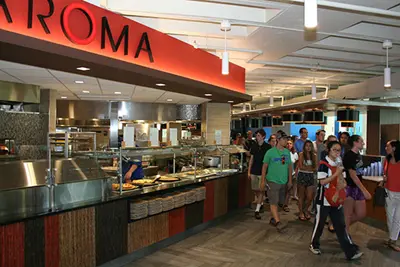Dining Services Cooks Up Classes for Students
 Image by Tory Germann
Image by Tory Germann
04/26/2017
By David Perry
Eliana Ramirez stared at the slimy brown maw of the monkfish.
The fish gazed back from a bed of ice, motionless.
To the freshman math major, it didn’t add up. Ramirez wasn’t sure about eating such a homely looking fish.
“It’s a face only a mother could love,” noted Frank Hurley, Dining Services’ head chef.
It was the sort of face that would yield the evening’s dinner for Ramirez and 15 other students at a recent cooking class offered by Dining Services. The class, held at University Suites, aimed at imparting culinary knowledge and giving students a behind-the-scenes view into what goes into meal preparation on campus. The event also highlighted efforts to use locally sourced foods in campus dining halls.
“I have to learn how to cook at some point,” Ramirez said. “When I move out of my house, I’m still going to have to eat. I can make things from a box. I can toast bread and put butter on it, but I need to learn to boil and grill things, too.”
In full chef regalia, Hurley and an assistant were there to help. There was a portable kitchen of sorts, set up over a sheet of black plastic. Hurley demonstrated how to prepare each course.
The students sat at tables covered in linens, set with silverware. At each place was a booklet of recipes featured during the class.
The meal started with New England clam chowder: onion, celery, flour, clam stock, cream, bay leaves and potatoes, cooked on low heat for 20 minutes. Then the clams were added and the whole thing seasoned to taste.
 Image by Tory Germann
Image by Tory Germann
“A good soup takes a half-hour to simmer,” Hurley told the students. “The longer it cooks, the more flavor it has. At home, you’ll want to cook this lower and slower.”
The students sampled the steaming bowls of chowder. If anyone disliked it, they didn’t say.
Then came the monkfish, a difficult fish to cook properly and much maligned, according to Hurley. The “lazy lobster,” some call it, because it hunts for food from the bottom of the sea.
Hurley expertly removed the cheeks, dipped the white flesh into a seasoned flour mixture and pan-fried it to a golden brown. He demonstrated how to slip the fish into the crackling oil slowly, to avoid splashing.
Next, Hurley added a white wine sauce, chopped tomatoes and chives, and a dash of crushed red pepper. He plated the fish over spinach and grits laced with cave-aged cheddar cheese.

“It was surprisingly good,” Ramirez said. “I didn’t know how I would like it. I’d totally do it again, and I think I’m going to try to make it for my parents.”
The evening’s meal finished off with Indian pudding for dessert, something many of the students had never sampled.
Dining Services hosted a previous cooking class on foods that students can prepare in a cup, and there will be more classes in the fall, said Rachel DiGregorio, marketing manager for University Dining. In addition to introducing them to new foods or cooking techniques, the classes let students get to know the dining staff.
“We’re able to really put a face to the dining service and makes it less impersonal,” said DiGregorio. “It’s fun to meet the chef, but they also get to see the talent these folks have.”




